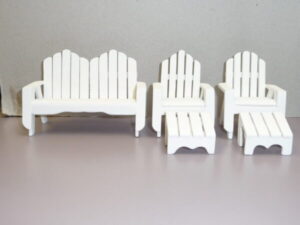 Keeping your well-loved miniature collection clean, preserved, and safe over time requires a gentle touch and a bit of know-how. Whether you’re caring for an antique dollhouse that’s been in the family for decades or curating new addition to your growing collection, regular maintenance ensures that your tiny treasures continue to shine with the same charm they had on day one.
Keeping your well-loved miniature collection clean, preserved, and safe over time requires a gentle touch and a bit of know-how. Whether you’re caring for an antique dollhouse that’s been in the family for decades or curating new addition to your growing collection, regular maintenance ensures that your tiny treasures continue to shine with the same charm they had on day one.
Keeping Your Miniatures Looking Their Best
Dust Is the Enemy
Dust may seem like a minor nuisance at first, but it can dull finishes, settle into fabric, and wear down painted details over time. Regular dusting is the easier and most effective way to preserve your miniatures, yet it’s often the most overlooked. Even a thin layer of dust can make vibrant colors appear muted and age delicate details prematurely.
Soft-bristled brushes—like those made for makeup, watercolor painting, or cameras—can gently sweep away surface dust without disturbing paint or glue. Canned air, used sparingly and at a safe distance, can help dislodge particles from hard-to-reach places like carved leg chairs or intricate lighting fixtures. A dry microfiber cloth works well for larger flat surfaces, such as the walls or floors of a dollhouse room. For older, more fragile pieces, avoid anything too abrasive. In many cases, a gentle puff of breath and a steady hand are all that’s needed.
Handling Vintage Pieces with Care
Vintage miniatures often come with delicate finishes, aged materials, and more fragile joints or glued parts. Each time you handle a piece, you run the risk of loosening these fragile connections, so be sure to approach with care. Clean, dry hands are a must, and for your most precious pieces, consider wearing soft cotton gloves to prevent natural skin oils from leaving residue.
It’s also important to handle furniture and accessories from the base rather than the top or corners. For example, lifting a miniature chair, grasp it by the seat rather than pulling on the backrest or legs. Avoid placing unnecessary pressure on small elements like knobs, drawer pulls, or porcelain trims. If a piece feels loose or unstable, store it safely and consider seeking professional advice before making repairs that could inadvertently cause more harm than good.
Cleaning by Material Type
Wood, Fabric, Metal, and Porcelain
Miniatures are made from a variety of materials, each requiring its own approach to cleaning. With wood furniture, avoid over-saturating. Use a soft cloth slightly dampened with water or a diluted white vinegar solution to gently remove grim, then follow up with a dry cloth. Be especially cautious with painted or varnished finishes, which can lift if exposed to moisture for too long.
Fabric items—like bedding, window drapes, or upholstered chairs—require even more care. Never submerge them in water or use strong fabric cleaners. Instead, remove line and particles using a lint roller, masking tape, or a clean mascara spoolie. For small stains, a slightly damp cotton swab can help, but always test on a hidden area first.
Metal pieces, such as chandeliers or hardware, are prone to tarnishing. Polish gentle with a soft, dry cloth. Avoid any chemical-based cleaners unless you know the exact metal type and how it reacts. Porcelain miniatures, often used in dolls or accent pieces, should be cleaned with soft brushes only—water can weaken any glue or detailing.
Avoiding Common Mistakes
One of the most common and damaging mistakes collectors make is using standard household cleaning products on miniatures. Cleaners with ammonia, bleach, or alcohol can strip paint, cloud finishes, or dissolve glues that are decades old. The same goes for overly wet cloths or rough sponges, which can scratch surfaces or cause wood to swell.
It’s also important to test any cleaning approach in an inconspicuous area first. Take your time, and when in doubt, opt for the gentlest method possible. Remember that natural wear and age is often part of the charm of antique miniatures. Over-cleaning can erase character and even reduce value.
Storing Miniatures When Not on Display
Temperature and Humidity Control
If you’re rotating pieces in and out of seasonal scenes or storing them between displays, proper storage is vital. Your miniatures should be kept in a dry, temperature-controlled environment to avoid warping, rusting, or mold growth. Avoid storing them in spaces prone to heat or cold fluctuations, like attics, garages, or unfinished basements.
Excessive humidity can soften glues and attract pests, while dry air can make delicate materials brittle. A small room humidifier or dehumidifier can help stabilize the environment depending on the season. If you’re storing your collection long-term, consider monitoring the storage area with a hygrometer to ensure the conditions stay ideal.
Using Archival Containers and Padding
Storing your miniatures in quality containers can make a world of difference. Acid-free tissue paper helps prevent yellowing and deterioration of delicate surfaces. Wrap the items carefully and individually, taking extra care with anything that has pointed edges or breakable parts, and store them in clear plastic bins or archival boxes for easy visibility or organization.
Custom foam padding, velvet-lined trays, and even sectioned jewelry organizers are all perfect for tiny accessories. Always label containers with contents and room assignments so reassembling scenes becomes and enjoyable experience rather than a confusing one. Take photos of your rooms before packing them away—they can serve as helpful references later.
Restoring Damaged Items with Love
What Can Be DIY and What Should Be Left to Experts
While some repairs can be done at home with miniature-safe glues and point, more complex damage—such as cracked porcelain, warped wood, or missing limbs on antique dolls—requires expert restoration. If you try to repair these items without the right materials or experience, you can cause further damage that’s often irreversible.
That’s why our Doll Hospital exists. At Gigi’s Dolls and Sherry’s Teddy Bears, we take great pride in restoring damaged or well-loved piece with a careful, respectful touch. Whether it’s a tiny tea set handed down from a grandmother or a dollhouse fireplace that’s lost its glow, we understand the sentimental value behind every repair.
Preserving Family Heirlooms
Miniatures often carry far more than just decorative value. These artifacts are deeply personal, often tied to family history and childhood memories. When cared for properly, these pieces can be passed down from one generation to the next. Cleaning and preserving them thoughtfully ensure their stories continue. So, whether you’re safeguarding your first treasured room or curating a decades-old collection, keeping your dollhouse miniatures clean and cared for allows them to be admired for years to come. With the right approach, even the smallest piece can become timeless.
Here at Gigi’s Dolls and Sherry’s Teddy Bears, we strive to provide you with dollhouse miniatures that have stood the best of time and all the information you need to ensure they continue to do so. Feel free to browse our inventory or contact us today to learn more about the various products we sell!


